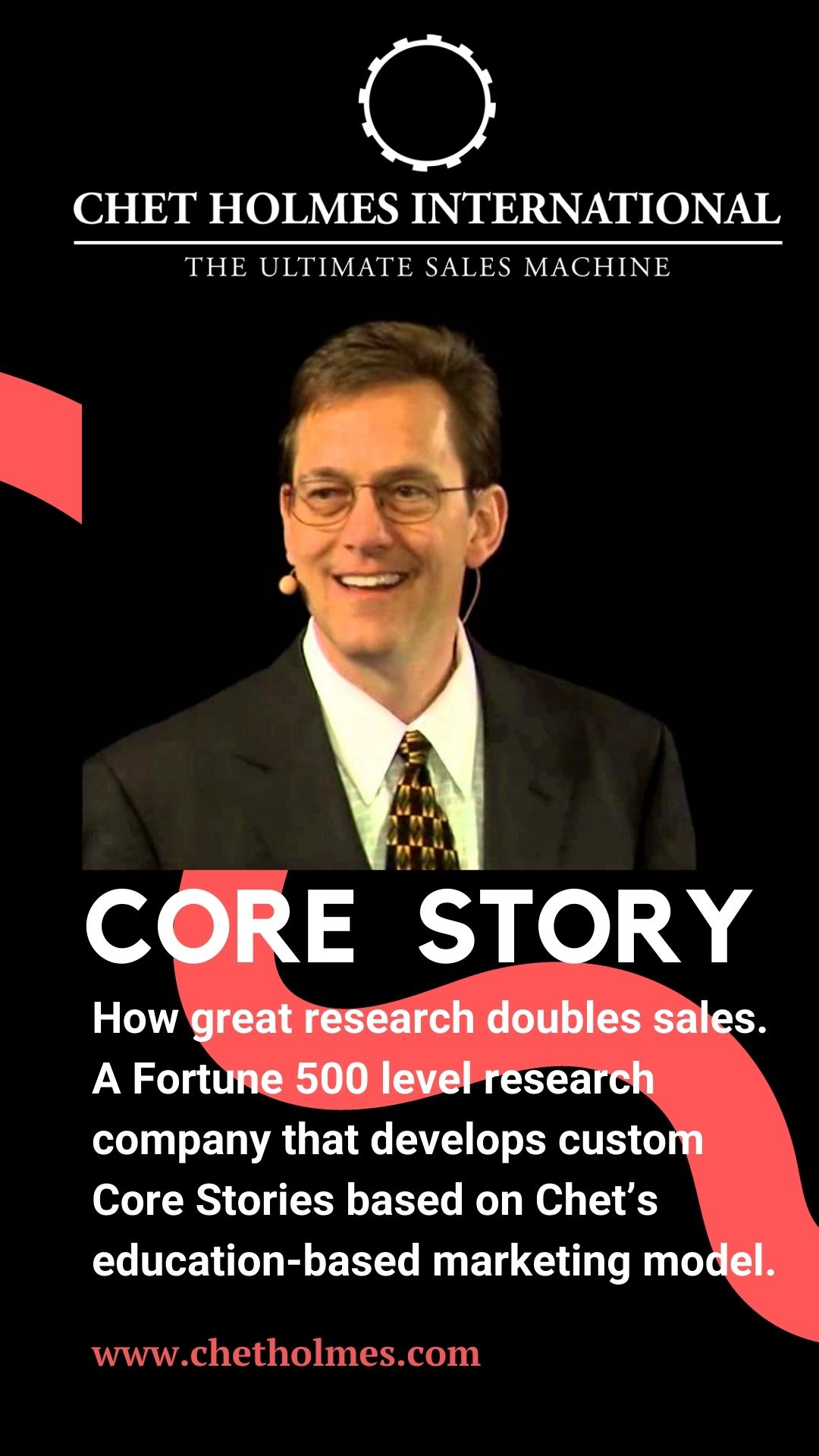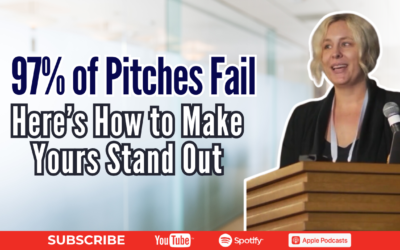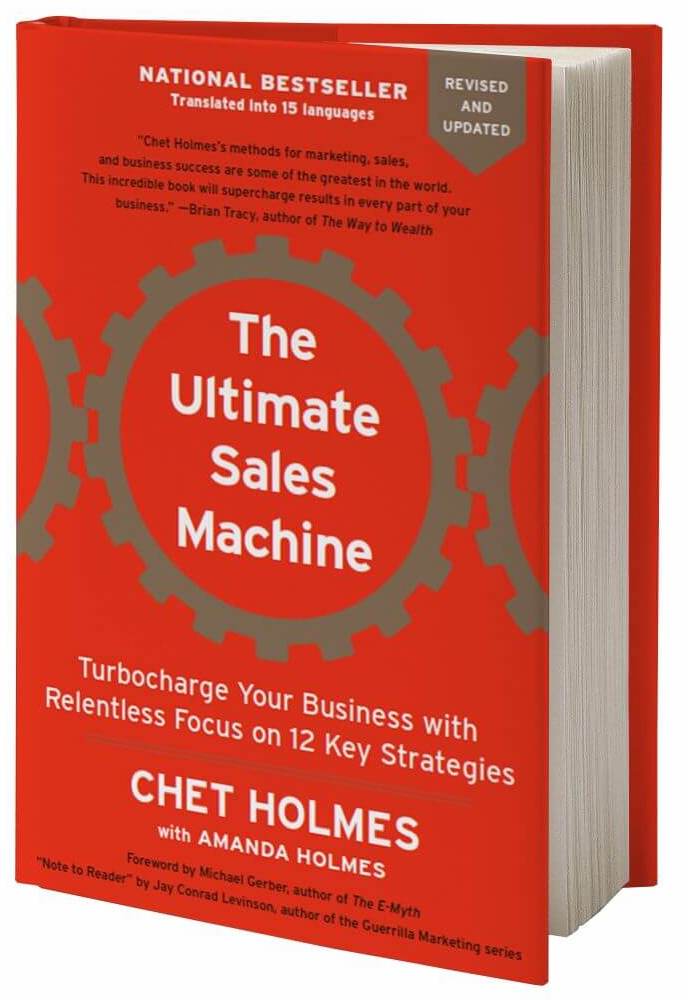“Working on your business instead of in it” is a phrase commonly heard in the entrepreneurial industry.
In this throwback training video, Chet Holmes shares actionable ways to work ON your business so that it operates consistently, profitably, and self-sufficiently.
Enjoy!
P.S. Want to STOP overworking and START generating more revenue with less stress?
If the answer is yes, then apply for a complimentary strategy session with one of our growth specialists to find where you’re leaving money on the table today.
- Want to know what’s keeping you from doubling your sales in the next 12 months? Take our quick QUIZ to get answers: Howtodoublesales.com
- If you’d like to have a profound breakthrough in your business, schedule your breakthrough call with a LIVE expert here: Chetholmes.com/Breakthrough
- Claim your FREE chapter 4 from the top 10 most recommended marketing and sales books of all time! Visit: Ultimatesalesmachine.com to find out how you Create 9X More Impact from every move you’re already making to win clients!
TRANSCRIPT:
*this transcript was mostly generated by AI, please excuse any mistakes 
Congratulations.
You just worked on the business. How’s it feel? Feels good.
What did you learn? What was that experience like? Feels good, right?
You’re proactively moving the business forward, so we’ve only just begun.
Now let’s show you how to fix and improve the things you. Outlined.
Here is your dose of the Ultimate Sales machine coming to you from the new edition. Visit ultimate sales machine.com to get your copy or multiple copies. Hi, I’m your host, Amanda Holmes, CEO of Chet Homes International. What you’re about to learn has assisted a quarter of a million businesses to generate billions of dollars working faster, better, smarter.
Okay. Large company model, again, let’s say you pinpointed six areas of impact. You hold six meetings per week where possible.
Some of you travel or whatever, but when you can, you do it. And I’ll tell you what my rules are, is that just put this in your calendar for the next year and every person on my staff, and there’s a ton of them here, will tell you like, I get really pissed off. I’m saying it g. So like our guy Gary last night, I was, had probably stronger passionate words for it.
My staff will tell you. But no, I really like, I tell people, don’t miss those meetings. You have to be dead or dying to miss those meetings. So we tell people if you have one hour a week, you put it in your calendar. If you’re in the sales team, then you only have one hour a week. You plan everything else around that one hour because I’m not gonna have a separate meeting for the one person who missed that meeting.
And if the meeting’s really great, you’re gonna make major progress in each. So we just hold their feet to the fire. You say you will show up for that meeting on time every single week. Without fail, I mean death or dying Vacation. Okay. Once or twice a year, you can miss the meeting. Um, the goal in the meeting is to cause constant and incremental improvement.
What does incremental mean? Means something on top of the thing you just did the week before. So everything is incremental. So at the end of the 52 weeks, a year from now, you are a transformed business because you’ve incrementally improved every single area of your company. The other rule is they always end on time no matter what.
You do not want people to go. Going into the black hole. , don’t know when I’ll be out. You want them to know. If it’s an hour, it’s an hour. We end our meetings, bam, on the minute, promptly wherever we are in that meeting. Small company, one person Army, basically. Same formula. Only your list is gonna be smaller, right?
You might spend that hour on six different things or four things. In fact, a small company you might want to tackle one thing one hour per week. and I’m gonna show you how to work on it. You get your prospecting down to a science or you work on your customer service procedures, or you make sure you’re marketing every single week.
And if you’re one person, army, you should be marketing every single day. But that’s another session and it’s coming up.
Okay? Same. Uh, questions
to prove a point. Small companies with three or less employees, raise your hand if you keep religiously spending one hour per week proactively improving some aspect of your.
One hour a week no matter what. Okay, that’s fantastic. Uh, where time is set aside just to perfect some aspect of the business, and you let nothing interrupt this. You don’t do emails, you don’t take phone calls. You, and if you have, if you’re a store and it’s nine to five or nine to nine or whatever it is, then the meeting is from eight to nine when you know you don’t have to work with customers or clients.
So let’s define the workshop method of company. This is a fantastic way of improving anything in any company L way to literally solve every problem you have in your company or cause continuous improvement and just stop and work on the business. So you take something and you put it on the whiteboard, and if you’re one person army, you write it on a sheet of paper and then you give yourself five minutes to brain storm on it.
So here we go.
Leading a group workshop.
Let’s say that right now I want all of you to work on methods to establish stronger rapport with your clients. And if I said to you, okay, I’m gonna give you two minutes to work on that, are you going to get ideas? Are you gonna enjoy the process? And then ultimately, is it gonna help improve your company?
So once a week, you’re gonna put this on the whiteboard. Uh, workshop assign everyone to create a list of at least six different ways to establish better rapport with clients. I’d say three would probably be more realistic, cuz most people can’t think of six. Once this is done, you assign a chairperson, so I’m showing you how to work a large group.
So some of you have larger companies. So what I do right now, if we were doing this, you guys as a group, is I’d say, okay, right about. We got six people here and six people here. I want you guys to turn around and face the six people behind you and the same behind you, and the same behind you. And in about three or four minutes I could organize you guys into a group of about 40, 40 different work groups.
Understand me so far. Okay. Then I say, now we need a chairperson to wrangle the group and corral the group. That’s somebody who’s not shy. That’s somebody who you know, doesn’t mind being in the spotlight. That’s somebody who doesn’t mind representing the group and talking to the rest of us. That person usually will volunteer right away.
So in each group, I want one person to raise their hand, who knows? They’re the chairperson, and usually everyone will, except in England. They go, no, no, you be the chairperson. No, no, really, they’re too polite. So I have to go around and pick chairperson for every group, and I’m serious. It’s amazing. The leader, the CEO summarizes.
So what happens is now the leader of the workshop has tremendous control. So you want to talk about a way to get your team on the same page and yet at the same time really control the process. So now I go, okay, uh, this group over here, you’re the chairperson. What were your ideas you had on rapport? And he starts giving to me.
Oh, very good. Great idea. And by the way, very important, you number each one, one. And I’m gonna show you why in a minute. Okay. And what’s your next one? Two, [00:06:00] and then three. And now I’ll go to this group and they’ll say one, two, and three. And then I’ll go to the group behind him and they’ll say one, two, and three.
And two is the same thing that he said the first time. So. So now the minute you start getting duplicates, you say No duplicates. And I will guarantee you we wouldn’t get six, seven groups back. in And then the rest of you will go, everything’s been covered. But it’s a powerful exercise to unite a group in something that you want to unite them in.
So if you have large scale organization and you want to unite them in something, then you as the leader, you can just outline everything that you want them united in. And because you control it says it here, probe for deeper understanding and add your own input along the way. So you go, what do you mean?
Give me an example. Great idea. And I’d like to add to. And I’m in control, right? As the leader of the workshop. So you have tremendous control while at the same time getting the great brain power of the group. Does that make sense? Okay. Very powerful. Try to continually [00:07:00] compliment and encourage a comments or folks will dread the meetings.
So what’s an idea? You have a rapport.
That’s another example. By the way, you’re gonna learn why. What I just did is a really stupid thing to do, Mike. An idea to build. Um, Twitter. Stupid idea. . Anybody else? , get the idea. . Okay.
It’s good. Thank you. It’s not really stupid idea. It’s a great idea. , I missed something last night if it is , but my point to you is I’ve seen this where I’ll teach a CEO how to do the meeting and then he’ll do the meeting and he’ll go, we’ve discussed that before and I’ve told you that’s a really dumb idea.
How about you? What’s your. You know, and everyone’s like, um, I don’t really, I’m all out, you know, . So you need to make it a pleasant environment where nobody minds sharing. They’ll all share openly other rules. You’ve state a fixed period of [00:08:00] time to solve a problem. So if I say to you, I’m gonna give you five minutes to work on rapport ideas, right now, it’s five minutes.
And then I will prompt you all along the way. You have two minutes left. You have a minute left. Okay. Wrap it up. That’s your planning. Now if we’ve done that with this group and we’ve written six, um, rapport ideas down that we think would help, some of them are gonna require some procedures, right? And procedures shouldn’t just be rolled out as if they’re the rule.
They need to be tested first. So the procedures are tested and when they work, then they become company. What policies? Okay. And it says never have anyone do everything all at once. It’s a terrible. Um, we have a lot of lot going on in all of our companies, and in one of them, we just recently doubled the price of something, so I took the very best producer we had, we gave him the assignment, he went out and he tried it, and I swarmed to secrecy.
You can’t tell anybody else you’re doing this no matter what. [00:09:00] If your results are good or bad, I don’t want you saying a. And I get them to agree to that before I even let them do the test. And most top producers can’t wait to be, you know, gimme some new assignment, you know? So he went out, he tried it, he, his closing ratio stayed the same, double the price, exact same closing ratio, pretty good test.
Then we tried it with the second person, another top producer, and then he had the same results. Now we can parade those top producers in front of all the other salespeople and let them tell you, I don’t have to tell. How did it go? Went great. I closed the same amount. I closed 43% at this price. I closed 43% at this price, and by the way, I’m gonna increase your pay cuz of that doubled increase.
We gave them a 43% increase in commission for the same job they were already doing. Do you think they were happy? Yes, they were very happy and so was I because as you’re gonna learn in another module, the way you get the best people is you gotta find ways to pay them really well.
Okay, so don’t do put [00:10:00] people on the spot workshops.
That’s what I did with Mike. I put ’em on the spot. Gimme an idea for rapport. deer in the headlights. Okay, gimme three ideas right now to grow your company. And I’ve seen this, you know, CEOs bring people together. Okay, I want an idea on how we can solve the most recent. Sam, what do you think? So give them a minute to think about it, and the quality of the answers goes up a hundred fold.
So you really wanna just give people time to think about it. Say, all right, everybody takes three minutes and work on this Same thing. If you are the, you’re the solo entrepreneur. I didn’t say that very well, solopreneur. Did I say it right that time? Yeah. Thank you. Um, but the one person army it’s the same thing.
You put it on the pad of. If you wanna be dramatic and pretend you’ll have a staff, someday you get a whiteboard, you go, okay, everybody , you know, put it up on the whiteboard and never think you have to solve every problem or be the big thinker in any [00:11:00] situation. High level executives in most companies think they have to solve the problem.
I tell high executives the only thing you need to bring to a meeting is your. judgement If you wanna solve problems, just bring all those people. I have a client that has 120 locations and he is a really smart guy, so he didn’t use the brain power until I came along. He did never use the brain power of his group cuz he’s so smart.
He can think of everything. But how many better ideas do you think he got when he started asking the 120 people running all his locations, what their ideas were? Think he got a better quality of, uh, So don’t work so hard. As I said, the only thing you need to bring is your judgment and the ability to make decisions.
By the way, number one most important trait in Fortune 500 CEOs. Number one, decisiveness the ability to make decisions. Most people are weak at that. I will tell you, most people are weak at that. That’s why when we go over the module about what makes a [00:12:00] great salesperson is they. because most people can’t make decisions.
They don’t make decisions. They hem and they haul. So a top producer will help you make the decision, okay? Workshops will transform your ability to solve problems, having trouble implementing. You go back, you try to implement some of this stuff, you’re getting nothing but fight and resistance from your staff.
You say, okay, everybody, the workshop for today is, how can we get this stuff implemented? And you put that on the whiteboard. I want three ideas from every one of you on how we can get this core story sales model implemented now. They’re helping you do the thing they were fighting you. Okay? So you want to involve them in the process.
It’s hard not to have buy-in to something that you help create, isn’t it? Okay, so let’s look at different methods for workshop. If you’ve got four people, you can work separately and then talk as a group. Same thing. If you have two people, if you have two people, you don’t sit there and talk about it. You say, let’s both think about it for five minutes.
And, uh, we did this with our own group, uh, in a workshop [00:13:00] and. I had 32 of my consultants in a meeting and we were trying to figure out a very complex thing and I said, oh, let’s do workshop on it and let’s get everybody’s ideas. And I ended up coming up with ideas that solved a lot of our problems, but I, I hadn’t stopped to work on the business, so I’m like, huh, teach best what you need to learn.
Right. It really worked well. The larger the total group, the larger the workshop groups will be. So an example in if you have 50. You want to do five groups of 10 people, like we would do it here. I would just divide this table into two groups. You guys would turn around and you’d be a group. Okay?
Teleconference workshops, because now write free teleconference.com or free conference.com. With these kind of these services, they’re free, so if you have a hundred people all over the country, you can all get on the telephone and have a meeting. That’s what we do. By the way, we run sales meetings for our clients all over the world, all by t.
So it makes it so easy for large, [00:14:00] widespread groups to get together. So if you’re saying, oh, well I’ve got, you know, salespeople in 50 cities, I can’t, you know, I can’t do this workshop thing. It’s a conference call. We have 200 people working virtually all outta their house. Not one person goes into an office and they all get on the meetings every week.
You know, the people involved in this division get on that meeting. The people involved in that division get on this meeting. And so here’s where the numbering thing becomes very, Because now I’m doing a workshop on qualifying the buyer, finding the need, and I say, I want three or four questions you would ask every client that really gives you insight to help sell them.
Is that a good workshop, by the way? Would you like to do that with your staff or by yourself? If you’re one person, army, would it be effective? Yes. Would you enjoy the process? Would you make some progress? Okay, so we’ll do it. And then let’s say I had each one of you on a conference call. So then I say, okay, uh, Nancy, what do you got?
All right, blah, blah, blah, blah, blah. Okay? Yeah. All right. That’s gonna be number one. Everybody, and we’ll summarize it this way. And now I tell everybody what to [00:15:00] write down and what number it’s gonna have. Why is that important? Cuz you get five or six things into it and you go, you know, the one where we said, that’s the one I’m talking about?
Instead of going see number six, that’s the one I wanna talk. . So you real, it sounds like a simple little thing, but let me tell you like, this is hard In the field of school, of hard knocks, these are the things we learned to make this process. So you can do it in an organized way. Uh, get on the calls, assign the workshop to get the ideas.
Everyone writes down the same thing. And again, only new ideas. So if you have a large group, you won’t get six or seven people into any workshop where pretty much then you say, okay, now just new. And you’ve got the list of the names of the people who are supposed to be on there. You just go, Betty, no Pass, Sam Pass, Joe Pass, et cetera.
Or we hot seat, the activities that we wish to improve and you would not believe how. People just wanna skip those details. So I’ll say, oh, I see here that you had 10 attempts to get a meeting this week, and you got two. Congratulations. [00:16:00] Let’s talk about the eight. You didn’t. What about this one right here?
Let’s just take this guy, Sam. So you’re gonna see in another section how to get data from your people so you know how to correct them. And I’ll say, Sam, what, uh, what’d you say to this guy? You know, it was the, you know, basic thing. I wanna come and talk about paint. Uh, Sam, this is the third month, uh, 12th session we’ve covered on this.
No, I’m kidding. I won’t beat the guy up, but I’ll say, would it work better now, as a consultant, you don’t have a. So that’s why if you are not doing a good job, I will actually fire you as a client. And I’ve done it really big. Clients just said, you know what, I’m, I don’t wanna waste my time and your money.
So if we’re gonna show up at this workshop and you’ve promised me you’re gonna do things, then you gotta do them. Or you’re wasting my, my time and your money. But you get the right type of consultant involved and they bring their own ambition to your ge your deal. You understand that? It’s like I don’t get involved to.
So if I’m gonna take you on as a client, you gotta work. [00:17:00] Or I will fire you and I’ve done it big names. You’d be surprised you fired so-and-so. Heck yes. So you wanna hot seat to people and try to get, extract the ideas and don’t, you know, go chinsy on the details. You want the details. I wanna know, I wanna role play with him.
I wanna know, what did you say then? What did he say? What did you say? What did they. And every week we go over and in fact, in my telemarketing division where we have the virtual call center, we go over the same script every week and we might add one word that makes it better. And some weeks we get really good ideas, don’t we, Ted?
It’s like, whoa, that changes everything. That’s a great idea. Okay, so you just wanna work on that business constantly.
How many people familiar with GoToMeeting? Okay. How many people not familiar with it at all? Never. . Okay. Just for you people, I will explain, and for people watching this at home, there’s a service called gotomeeting.com.
And for 50 bucks, what it does is say, I’m [00:18:00] on the phone with you and I go, uh, you know what? Let me show you this. Uh, you have, you have your computer go to go to meeting.com. On the left hand side, it says, join a meeting, click that, uh, and then I do the same thing. I go start a meeting, and then I find the, I’ve got a access code and I say, there’s punch in that access code and ban the guy seeing my.
Whatever I put up on my screen, he’s seeing if I wanna show ’em this, I show ’em this. I wanna show ’em pictures of my kids. I wanna show ’em spreadsheets, I wanna show ’em PowerPoint. It’s a really cool tool. And 50 bucks a month, you can have up to 11 people on those meetings every week. $79 a month. You can have up to a hundred for go to webinar.com.
And also these are great tools for you to use for your webinar division. So we talked about that. One person. Army Workshop. Same procedure. Put something on the top of the piece of paper you want to improve. Spend several minutes jotting down ideas. Then look at how to install the three Ps. What’s your plan?
What’s your procedures? And then what are the policies going to be so you can get that company running without you think big. [00:19:00] Think about the day when you will have 50 employees a week to hire. Okay? The more you install the three P’s, the better the company runs. So the art of the workshop, the real power of the workshop is just stopping everything and working on the challenges with deliberate intention to cause improvement.
It’s a mindset. And have I given you that mindset? Yes. Not really. Doesn’t sound like it. Do you have the mindset? Yeah. All right. Him better than anybody. I love that. Here’s the first walk workshop I do with every client. First workshop I do with every client, and we got the whole staff in the, in the, in the room, let’s say.
And we say, all right, what’s standing in the way of making this company? Faster and better.
So I want you to do that right now. What is standing in the way? Top three or four things, top five things. What’s standing in the way of making your company grow faster and run better?
Make sure to get your copy or copies at the ultimate sales machine.com. There’s a lot of special bonuses that you [00:20:00] can’t get going to Amazon, so make sure you check it [email protected].





 Get your pre-sale copy of the new edition of The Ultimate Sales Machine! (With special limited time bonuses)
Get your pre-sale copy of the new edition of The Ultimate Sales Machine! (With special limited time bonuses)
0 Comments